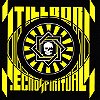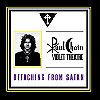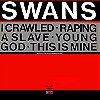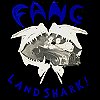Stillborn was conceived in Gothenburg, Sweden around 1984 when vocalist/bassist Kari Hokkanen, drummer Petter Bryneson and guitarist Ingemar Scott Henning got together. Initially, the group performed under the moniker of "Cranium", but then at some point opted to exchange it for "Stillborn". The line-up was later expanded when they met another guitarist named Erik Sandquist (supposedly at a concert of the German Industrial act, Einstürzende Neubaten). In 1985, the quartet recorded a limited-edition demo strangely entitled, Tounge The Thong (which I have yet to listen to in its entirety, as it seems to be very difficult to find). Soon after that, Petter departed from the group and Peter Asp was recruited as the new drummer. After securing a deal with Radium 226.05, the recording process for the first album, Necrospirituals, finally got underway in 1988, and was released a year later. On their debut, Stillborn gathers influence from Goth Rock, Doom Metal, Hard Rock and even a little of Psychobilly. This Swedish foursome had a very distinct style, not really sounding much like any other Metal act of the current time. However, references could be made towards Black Sabbath (the classic Ozzy Osbourne era to be precise), The Sisters Of Mercy, Danzig and maybe even Christian Death (also, New York's Type O Negative, although in 1989 they didn't really exist. At the time, they had already formed as Repulsion, but they did not have any official recordings out, so I would probably not count them yet). Interestingly enough, Country music singer Lee Hazlewood was an inspiration too (according to some of the members). To me, Stillborn have always been one of the "unsung progenitors" of Gothic Metal who were there at the very beginning. Unfortunately, they are rarely ever mentioned by any publications or almost anyone in general (not even on the internet, it seems). I believe some of the music present on Necrospirituals was definitely ahead of its time and may have actually been part of the foundation which later Gothic Metal groups built on. When this album saw the light of day, there really wasn't (m)any other groups meshing Goth Rock with Doom Metal (at least, not any whose existence I'm aware of. There might be a select few others who like Stillborn have been buried by time and obscurity though). In an interview I managed to dig up, the members of Stillborn stated that while they were indeed influenced by the whole Post-Punk and Goth Rock scenes of the 1980s, they personally thought that most groups belonging to it were kind of "boring", so they decided to add the ingredients of "heaviness" and "disturbing" lyrical content to their own music, in the process helping to unintentionally develop a whole new style of Metal (only that back then there was no term to label their music with).
For those that may not know, the first "official" Gothic Metal groups arrived years later in the early-to-mid 1990s with the likes of Type O Negative, Saviour Machine (which is another forgotten trailblazer of this sub-subgenre), Paradise Lost, Tiamat, Cemetary, Moonspell, Lake Of Tears, The Gathering, Theatre Of Tragedy, Tristania etc. What Stillborn did from 1985 to 1989 (play Doom Metal within a Goth Rock-inspired context, featuring a vocalist with a very deep bass/baritone voice) would be done to death years later in the 1990s by dozens of other newer groups trying to emulate the formula of Type O Negative (who were the first group to successfully popularize this style). So, for a band to have been playing a prototypical form of Gothic Metal back in the 1980s just seems like a unique and innovative idea to me, especially considering that at the time Heavy Metal, Thrash Metal and Glam Metal were the Metal styles that appeared to be the most widespread (but even in the burgeoning underground Doom Metal scene of this decade, I still can't think of another band whose style resembled that of Stillborn. Italy's Black Hole and Bellzlleb from Japan both also had a primeval "Gothic Doom" sound, but still were not very similar). One should keep in mind that isn't the modern kind of Gothic Metal that most people these days are accustomed to (you know, the kind that has feminine vocals and atmospheric keyboards galore. A couple of these elements are present here too at some time or another, but not in much abundance). Stillborn's brand of Gothic Metal tends to be more "stripped down", injected with a good, healthy dose of testosterone and mainly devoid of those "Victorian" elements that have since then been commonly associated with this style of Metal (whether that is a positive thing or not is all a matter of personal preference). Getting into the musical content present on Necrospirituals, the opening track, "Nuke 'Em All", reeks of gritty Southern Hard Rock (and some hard liquor as well). Plain and simple: It's really a swinging tune, one which would be right at home playing in some type of "roughneck" biker bar located somewhere in the deep south. The lyrics are somewhat comedic and satirical, as if these Swedes were making fun of a specific breed of Americans (allusions to the Ku Klux Klan, Budweiser beer, blue-collar workers and nuclear weapons are made here). From this, I can tell the members of Stillborn have a sense of humor and they probably don't take themselves too seriously. Also, I just can't help but want to shout along with Kari when he shouts, "NUKE 'EM ALL!!!". Turn this one up for your neighbors and let loose!
"God knows I'm a hard-working man
I eat Pittsburgh steel, shit Budweiser cans
I stand 6'5, weigh 249
I am a bad dream, baby, for the Ku Klux Klan
I am a man with a mission
A man with a call
A blue-collar ranger spitting thunderballs"
The sinister "Flesh For Iesus" ("Jesus" was probably the name intended, but there seems to have been a printing error with the title) is shades darker and loads heavier than its predecessor. Kari Hokkanen sounds all cold and emotionless here (and well, like some kind of morbid baritone-voiced vampire). During the chorus he malevolently snarls the cryptic, macabre lyrics, "IN THE YEAR OF THE HUNGRY WOLF. BRING US THE HEAD OF THE BOURGEOIS WHORE. HEADSMAN, HEADSMAN, FEED THE WOLF. BREED THE WOLF. JESUS PUT HIS TONGUE TO THE GORRREEE..." (whatever the hell that means). The nefarious guitars of Ingemar Henning and Erik Sandquist are also stained with Black Sabbath's influence. An unknown female vocalist makes a brief appearance halfway through, but it's mostly forgettable and a bit awkward or amateurish. While she doesn't necessarily ruin "Flesh For Iesus" or anything, her presence doesn't really add much substance to the composition. "Albino Flogged In Black" (which vaguely reminds me of Danzig's "She Rides") slowly comes in next with droning chime-like keyboards that are supplemented by churning guitars and Kari's deep, sultry vocals. The lascivious nature of the lyrics combined with the overall sensual tone of the music make this feel like a near-perfect song to have sexual relations to (preferably some time after midnight, ha ha). In the 1990s and 2000s, Paradise Lost, Entombed and Medicine Rain all went on to record their own covers of "Albino Flogged In Black", although none of those versions ever truly surpassed the original by Stillborn. The mood shifts from erotic to haunting on "I, The Stillborn". This might just be the greatest track found on Necrospirituals. It's also the one that is the most Gothic Metal in essence (this is what happens when Black Sabbath and Sisters Of Mercy get intermingled). Everything present here is enjoyable for me - From the brooding, nocturnal atmosphere to the gloomy, fuzz-drenched guitar riffs to the lyrics that remind me of some occult Horror film. Also not to forget Kari's gravelly, moribund voice which is certainly an important aspect of this album (without it, things wouldn't quite be the same). The majority of the time when I hear his voice, I just can't help but wonder if Peter Steele and Type O Negative were aware of Kari and Stillborn's existence (or not), as there are several striking similarities between the two groups. "Calvaria 1939" is rather repetitive with simple buzzsaw guitars, but this is a case of "good repetition" (also steers towards the same "Sabbath-meets-Sisters" approach, which at this time was pretty unique). Certainly another personal favorite of mine. The lyricism here evokes some interesting, vivid imagery in my mind as I can picture Death (or a zombie of sorts) riding on a shadowy, demonic stallion as it makes some type of unholy journey across a barren, arctic desert.
"Can you hear the hoofs?
'Cause I am the black night
Riding on a dead horse
Storming 'cross the "Old Ice"
Can you hear them call?
You got to hear them call
Behind those white hills
And I know I'm almost there"
"Streetsatan" can be thought of as the black sheep of Necrospirituals. While the majority of the tracks on this album are either of the prototypical Gothic Metal, Doom Metal or Hard Rock genus, "Streetsatan" traverses into Psychobilly territory! For this reason, some may feel it doesn't properly belong here. Admittedly, it does sound slightly out of place, but I don't mind it. On this energetic cut about motorcycles and leather-clad outlaws, Stillborn comes across like a darker, heavier version of Social Distortion. A session member named Rune Johansson is brought in to play a wild harmonica, which further gives "Streetsatan" that whole Rockabilly/Psychobilly vibe. The sonic debauchery resumes with "Raising Fits Cain", a raunchy Hard Rock anthem that is contagious as hell (that chorus was meant for singing along to while drunk!). Call it "cheesy", "corny", "creamy" or any other silly food-related adjectives you may want to use, but guess what? I still dig it. Now that I think of it, "Raising Fits Cain" would surely not be out of place playing at some sleazy strip joint. "Angelynx" begins with ominous Black Sabbath guitar chords and some eerie keys (courtesy of session member, Niklas Sundling) before going through a pastoral Folk-styled passage of springing acoustic strings. Around the 1:30 minute mark Stillborn finally gets the momentum going with some driving, ballsy guitar riffs. A rad way to go out. Well, I imagine that most individuals who get the opportunity to listen to Necrospirituals will either not care much for it or just criticize it as an insignificant and inconsistent record (one that should be left in the underground vault to rot). The ones who will get the most out of this trailblazing, proto-Gothic Metal record will probably be those who know how to genuinely appreciate and enjoy all forms of Goth music. Unfortunately, the classic line-up of Stillborn disintegrated shortly after the release of this album, and they would not be entirely the same as the group went into a slightly different (also more generic) Thrash Metal direction later on. Fortunately, in 2017 all the original members that performed on the 1989 debut reunited again after nearly three decades and recorded a new album titled Nocturnals. Enthusiasts of Necrospirituals should also go and check that out if possible, not to forget the Yesterdays Blood single that was remastered and released in 2003 (this includes the title track which was taken directly from the aforementioned 1985 Tounge The Thong demo and "Son Of Sodom", another rare track from a 1987 demo tape. These two killer tracks only further prove that Stillborn was indeed, at the forefront of the whole Gothic Metal scene).
 Login
Login

 Message
Message
 Home
Home 12 Reviews
12 Reviews Collections
Collections










 0 comments,
0 comments, 







